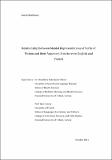| dc.contributor.advisor | Antonijevic-Elliott, Stanislava | |
| dc.contributor.advisor | Conroy, Jane | |
| dc.contributor.author | Berthaud, Sarah Isabelle | |
| dc.date.accessioned | 2012-05-09T15:42:17Z | |
| dc.date.issued | 2011-11-01 | |
| dc.identifier.uri | http://hdl.handle.net/10379/2744 | |
| dc.description.abstract | This thesis presents the results of three experiments aimed at examining whether representations of verbs of motion and their argument structures in the first language (L1) mental lexicon influence the acquisition of verbs and compatible argument structures in the second language (L2).
French and English rely on different lexicalisation patterns to describe motion events. Research indicates that native English speakers dominantly prefer to encode manner of motion in the main verb and describe path of motion with a prepositional phrase. French speakers dominantly encode path of motion in the main verb and optionally describe manner of motion in an adjunct.
In all 3 studies, the participants were English native speakers learning French L2 and French native speakers learning English L2 with 2 different levels of proficiency: upper-intermediate and advanced. Professional translators and early bilinguals were used as control groups; translators are specifically taught how to translate sentences from one language to another, and early bilinguals simultaneously acquire both languages.
The first experiment was aimed at systematically examining the effect of animacy of the sentence subject on the choice of verb of motion and its compatible argument structure in L2 English and L2 French.
The second study examined how the proficiency level of L2 learners influenced the acquisition of a new typology of verbs. Due to typological differences between French and English, L2 learners might encounter difficulties in acquiring the new typology and therefore make errors in sentence production. In this study, the typology of verbs (path/manner of motion) was systematically varied.
The third study examined the sensitivity to differences in verb and argument structures between L1 and L2. Three types of verbs were included: (i) verbs that have direct translational equivalents, (ii) verbs that have semi-translational equivalents, (iii) verbs that are described by incongruent translations in French and English. | en_US |
| dc.rights | Attribution-NonCommercial-NoDerivs 3.0 Ireland | |
| dc.rights.uri | https://creativecommons.org/licenses/by-nc-nd/3.0/ie/ | |
| dc.subject | Bilingualism | en_US |
| dc.subject | Second Language Acquisition | en_US |
| dc.subject | Motion events | en_US |
| dc.subject | Psycholinguistics | en_US |
| dc.title | Relationship between Mental Representations of Verbs of Motion and their Argument Structures in English and French | en_US |
| dc.type | Thesis | en_US |
| dc.contributor.funder | IRCSET | en_US |
| dc.local.note | This thesis examines how verbs of motion and the structures they can be associated with are stored in the bilingual lexicon. It also examines how second language learning and second language production in French and English are influenced by the way they are stored. | en_US |
| dc.description.embargo | 2021-02-27 | |
| dc.local.final | Yes | en_US |
| nui.item.downloads | 64 | |


